A new modeling study suggests that disruptions to health services caused by COVID-19 could lead to an increase in HIV, tuberculosis, and malaria deaths.

Experts around the world expect the COVID-19 pandemic to have a significant impact on society. This includes not only the illness and deaths caused by the disease itself but also the economic consequences of global lockdowns and disruptions to essential services.
Experts indicate that the pandemic’s knock-on effects are likely to be most severe in low and middle-income countries, where health systems are less robust and economic reserves are more limited.
A particular concern is the impact of the pandemic on countries with high burdens of infectious diseases, such as HIV and tuberculosis (TB), which depend on regular, large-scale programs of control and treatment.
Stay informed with live updates on the current COVID-19 outbreak and visit our coronavirus hub for more advice on prevention and treatment.
A study published in The Lancet Global Health modeled the impact of disruptions caused by COVID-19, such as increased demand on healthcare systems and reductions to disease control programs, in low- and middle-income countries.
The study estimates that deaths due to HIV, TB, and malaria could increase over the next 5 years as a result of COVID-19 and could, in the worst-case scenario, occur on a similar scale to the direct impact of the pandemic.
The researchers based the study on a model that assumes a reproduction number of 3 for SARS-CoV-2, the virus that causes COVID-19.
The reproduction number, or R0, indicates the average number of new people who will contract the virus from one person who has it.
Using R0 as a starting point, the researchers modeled the impact of four different policy scenarios for COVID-19:
- taking no action
- mitigation, leading to a potential 45% reduction in R0 for 6 months
- suppression-lift, leading to a potential 75% reduction in R0 for 2 months
- suppression, leading to a potential 75% reduction in R0 lasting for 1 year
The researchers then used models of transm

